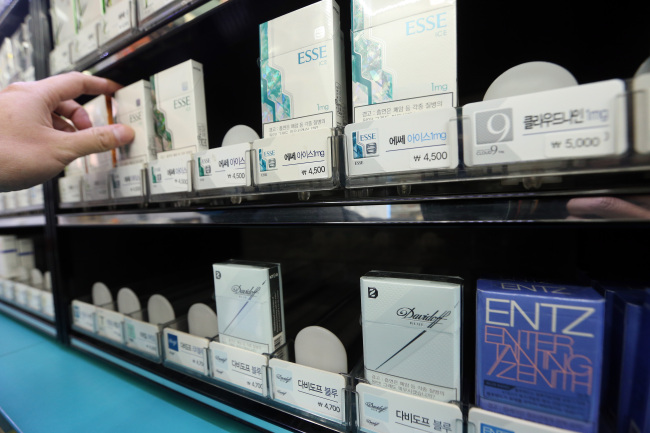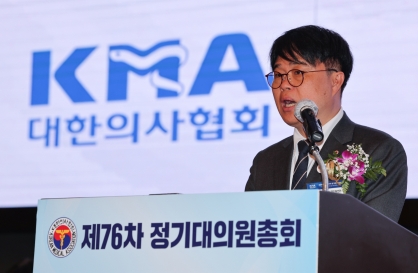While the new tobacco tax has been in effect in South Korea for only three weeks, smokers have already found various ways to fight the state-backed market.
With the turn of the year, the local price of a pack of cigarettes produced by KT&G, Philip Morris, British American Tobacco or Japan Tobacco International nearly doubled from 2,500 won to 4,500 won ($2.30 to $4.15).
The country’s market-based approach to encouraging smokers to quit, however, has had both bright and dark sides.
The ugly side effects of the economic policy include the personal use of corporate credit cards for buying cigarettes, illegal cigarette sales online and increasing visits by nonsmoking travelers to the cigarette section of duty-free shops.
“When we go on business trips, we use corporate credit cards to buy cigarettes at duty-free shops,” said a 35-year-old employee of an Incheon-based trade company, married with one child, who only gave his surname Kim. He said his colleagues, both smokers and nonsmokers, would each buy a box of cigarettes tax-free at the airport, and split them among the smokers.
“Some nonsmoking colleagues also want their share of tax-free cigarettes, for family gifts and so forth,” he added. The current duty-free price for Marlboro, produced by Philip Morris, is $19 per box, and Esse, produced by KT&G, is $18 ― considerably cheaper than the price in South Korean stores of about $41.
With the turn of the year, the local price of a pack of cigarettes produced by KT&G, Philip Morris, British American Tobacco or Japan Tobacco International nearly doubled from 2,500 won to 4,500 won ($2.30 to $4.15).
The country’s market-based approach to encouraging smokers to quit, however, has had both bright and dark sides.
The ugly side effects of the economic policy include the personal use of corporate credit cards for buying cigarettes, illegal cigarette sales online and increasing visits by nonsmoking travelers to the cigarette section of duty-free shops.
“When we go on business trips, we use corporate credit cards to buy cigarettes at duty-free shops,” said a 35-year-old employee of an Incheon-based trade company, married with one child, who only gave his surname Kim. He said his colleagues, both smokers and nonsmokers, would each buy a box of cigarettes tax-free at the airport, and split them among the smokers.
“Some nonsmoking colleagues also want their share of tax-free cigarettes, for family gifts and so forth,” he added. The current duty-free price for Marlboro, produced by Philip Morris, is $19 per box, and Esse, produced by KT&G, is $18 ― considerably cheaper than the price in South Korean stores of about $41.

Illegal online cigarette sales have also risen. Seeking a quick and safe investment, some consumers with clean criminal records have been caught selling cigarettes online. Recently, the police revealed a case of four young men in their early 30s who were arrested for selling about 3,200 packs of cigarettes online. They began hoarding the products in November last year, when cigarette prices were almost half the current price.
The police are cracking down on similar cases, horrifying many sellers who didn’t realize that only state-authorized retailers could sell tobacco products.
The sharp price increase has also had a bright side.
“I smoked my last cigarette on Dec. 31,” said Song Won-jae, an employee at a computer security firm. The 30-year-old found the idea of controlling smoking with prices “humiliating and dirty,” but admitted that the main reason he quit was because the price would only continue to rise in the future.
Following the price jump, Song’s team began having fewer “hoesik” ― company dinners for strengthening team spirit ― because alcohol makes cigarettes more tempting. The smokers also began consuming the expensive commodity away from those who had quit, out of courtesy.
Nevertheless, the policy change has renewed the debate over the extent to which the state should intervene in an individual’s consumption habits.
Supporters of the policy point to the price shock strategy’s efficacy in deterring juvenile smokers. The opposition, however, contends that the policy is a government-led scheme to garner tax revenue.
“Smoking is an addiction and a disease, but the cessation of smoking is a matter of welfare,” says professor Park Young-chul, a toxicologist and chief of the GLP Center at the Catholic University of Daegu.
In his book “The Introductory Health Science for Smoking Cessation,” Park warns against the health damages of secondhand smoke. Only 15 percent of tobacco smoke, or “mainstream smoke,” is filtered and inhaled by the smoker. The remaining 85 percent, called “sidestream smoke,” is released from the lit end of the cigarette, and is easily inhaled by people standing nearby.
The epidemiologist’s view embraces the principles of the World Health Organization and its anitsmoking organization, the Framework Convention on Tobacco Control. The FCTC supports the economic approach to controlling smoking, including state-led price increases on tobacco products like health taxes on cigarettes.
While studies show that tobacco smoke contains about 4,000 different chemicals, researchers suspect that hundreds of thousands more chemicals are yet to be identified.
Entering the body, the toxic substances can undergo a biotransformation to yield reactive intermediates. However, this is insufficient to prove that a certain tobacco substance has a direct causal association with a particular disease.
Such uncertainties have earned victories for tobacco-makers in court since the country’s first tobacco-related lawsuit in 1999.
By Chung Joo-won (joowonc@heraldcorp.com)
-
Articles by Korea Herald





![[Weekender] How DDP emerged as an icon of Seoul](http://res.heraldm.com/phpwas/restmb_idxmake.php?idx=644&simg=/content/image/2024/04/25/20240425050915_0.jpg&u=)



![[Music in drama] An ode to childhood trauma](http://res.heraldm.com/phpwas/restmb_idxmake.php?idx=644&simg=/content/image/2024/04/25/20240425050929_0.jpg&u=)









![[Herald Interview] Mistakes turn into blessings in street performance, director says](http://res.heraldm.com/phpwas/restmb_idxmake.php?idx=652&simg=/content/image/2024/04/28/20240428050150_0.jpg&u=20240428174656)
